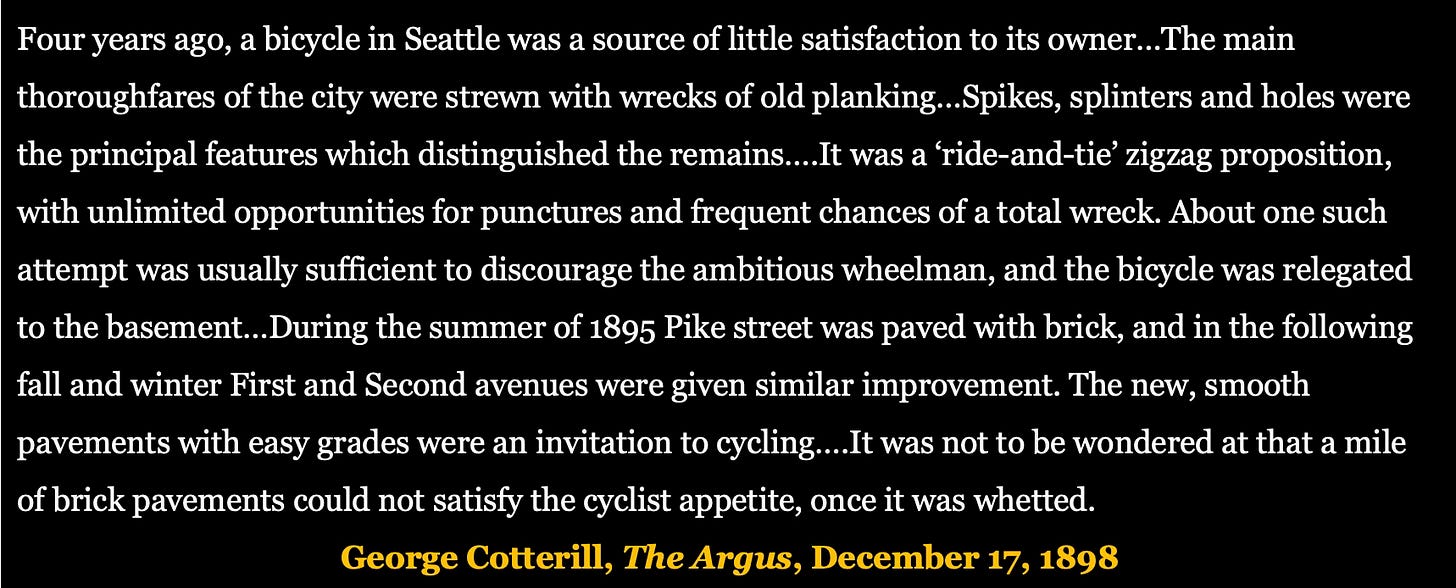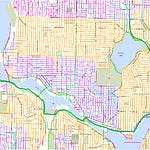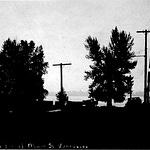One of life’s simple pleasure is bumping along. I was able to do this the other day, on an unusual road, bumping over brick on my bike. About 200 yards long and located just off SR-522 in Bothell, near the notorious Wayne curve, the red road is the lone remaining section of the Bothell Boulevard. When it opened in 1914, the Seattle P-I described the boulevard’s “scenic beauty…[as] the equal of any in or near this city.” By 1934, though the brick had been replaced with asphalt, except for this short section, which preservationists had to save again in the 1990s.
The Red Brick Road, as locals call it, is one of the few remaining sections of brick road in Seattle and environs. The longest is a bit over a mile; most are one block long or shorter. Back in the day, when hard surfaced roads began (~1895) to replace dirt, mud, and planking, brick was the most common “pavement” in the city. In fact, in 1917, the Denny-Renton Clay and Coal Company produced more paving bricks—58 million—than anyplace else in the known universe. DRCC bricks paved streets in Portland, San Francisco, Tokyo, Los Angeles, Chile, Argentina, and India.

DRCC was not the lone brick producer. A 1941, Washington State Department of Geology report noted: “Nearly every town in the Sound country at some time has had a brick yard.” They produced flower pots, terra cotta, and flue lining; drain pipe, plain pipe, and sewer pipe, common brick, face brick, fire brick, paving brick…you get the picture.
Not surprisingly, given my proclivities, geology is the reason for the brick, primarily because thick and wide-spread clay deposits abound. Local manufacturers quarried two clay layers: one about 40 to 45 million years old (quarries near Auburn and Taylor) and one deposited during the last Ice Age (quarries along the Duwamish River and near Renton).
The Ice Age clays make up the base of most hills in Seattle and were as simple to mine as scooping out hillsides. I was told by a modern brick producer that as many as 300 quarry sites dotted the Seattle area. “The lore that is passed down in our circles is that at nearly every early 20th century Seattle job-site (which used brick), a little brick company (however temporary) popped up.”
Here’s a link to a map I made with some of the brick remnants. Please let me know of others. I will add them to my map.
North Trunk Road - In October 1912, workers completed the North Trunk Road, which ran from about Green Lake to the Snohomish County line. Dirt at first, it was paved with brick in 1913, and in 1927, became part of the Seattle-Everett Highway and eventually part of the Pacific Highway. Like many brick roads, the final remnant (just east of Aurora Ave. N. and north and south of N. 175th St.) has survived because of preservationists, who recognized the history embedded in brick.
Yellowstone Trail - Begun in 1912 and completed by 1916, the Yellowstone Trail was the first transcontinental road. (They had a splendid motto—A Good Road from Plymouth Rock to Puget Sound—though organizers failed to note the glacial links between the end points.) To reach Seattle over the final miles from Snoqualmie Pass, the trail originally ended at Kirkland, where a Mosquito Fleet ferry transported cars to the east end of Madison Street. This remaining section of brick, about 1.3 miles long and running down 196th Ave. NE from NE Union Hill Road to SR-520 in Redmond, is listed as a King County Landmark and on the National Register of Historic Places.
Pike Place - The brick roadway in the Pike Place Market is easily the most encountered section of brick in the region. Sadly, the bricks are not historic; they were placed in 1979, as part of major renovations of the market.
Ballard - At the intersections of Ballard Ave. NW and 22nd Ave. NW and 20th Ave. NW. are two other, well-trod brick sections of road. But, alas, these are not historic either.
Alleys - When I was a child, we had a brick alley behind our house on 22nd Ave. E. between E. Highland Dr. and E. Galer St. Not surprisingly, I didn’t think much about this road surface. (My inner dorkdom didn’t develop until many years later.) One block west is another alley with brick. There’s also a brick alley (Post Alley) between S. Main St and S. Jackson St between 1st Ave. S and Alaskan Way S.
Gutters - Quite a few older streets in Seattle, ones covered in asphalt and setts (or cobblestones), have brick gutters about a foot wide. I suspect that many of these have survived because water and other debris flow more easily over the brick than over other, less smooth surfaces.
Two for one - I know of only one section of brick that has the additional historic element of rail. The brick runs along Terry Ave N. where it intersects with John Street. The rail was part of a Northern Pacific freight line (opened between 1905 and 1917) that accessed the warehouses and businesses that formerly dotted this formerly working class neighborhood. And, many decades ago, two blocks north was a freight yard; sadly nothing indicates this history.
Windows - These are the numerous locations where brick peeks through a newer road surface. Many such windows into the past have persisted for decades but many also pop up for the short time when roads are being repaired and/or repaved.
Finding these little encounters with the past please me immensely. Brick remnants such as these peek-a-boo windows, as well as the larger stretches of brick, are part of what makes a place more interesting and more complex; they are reminders that cities and their residents constantly change and reimagine themselves. Urban history is regularly wiped clean by what we call progress; we would be wise to not forget where we come from.
A very nice review of Wild in Seattle from Cascadia Daily News.
A complement to today’s brick newsletter is a story about Seattle’s cobblestones from the Seattle Times.
A fun story about a geyser messing with New York City’s subway system. “ It turns out that even though we have built all these big buildings and built roads everywhere, that topography is still there, and water, just as it always has done, runs downhill,” said Eric Sanderson, the vice president for Urban Conservation Center for Conservation and Restoration Ecology at the New York Botanic Garden.
And, finally, Seattle’s not alone in reimagining its waterfront. Yay Toronto. I apologize that the link may not work but at least you can try, if you desire.
Thanks for Heather Phil, John Cox, Austin Watson, Valarie Bunn, and Tom Fucoloro for information used in this newsletter.















Share this post